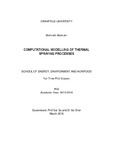JavaScript is disabled for your browser. Some features of this site may not work without it.
| dc.contributor.advisor | Gu, Sai | |
| dc.contributor.advisor | Sher, Ilai | |
| dc.contributor.author | Mahrukh, Mahrukh | |
| dc.date.accessioned | 2016-06-29T13:11:06Z | |
| dc.date.available | 2016-06-29T13:11:06Z | |
| dc.date.issued | 2016-03 | |
| dc.identifier.uri | http://dspace.lib.cranfield.ac.uk/handle/1826/10039 | |
| dc.description.abstract | The main aim of this project is to model the effects of varied injection parameters on the gas dynamics and droplet dynamics of the HVSFS and SP- HVOFS processes for improving the droplet breakup and evaporation to enhance the nanoparticles heating and deposition efficiency. Thermal spraying processes are widely used to generate thermal-, corrosion-, and wear-resistant layers over the machine parts, to increase the durability of the equipment under severe environmental conditions. The liquid feedstock is used to achieve nanostructured coatings. It is used either in the form of a suspension or a solution precursor. The suspension is a mixture of solid nanoparticles suspended in a liquid medium consisting, for instance, of water, ethanol, or isopropanol. This dispersion mechanism in a liquid carrier provides adequate flowability to the nanoparticles, which cannot be handled by conventional gas- based feeding systems, whereas the solution precursor is mixed at the molecular level; hence, more uniform phase composition and properties are expected in the sprayed coatings as compared to the suspension and conventional powder spraying. Firstly, experiments are conducted to analyse the effects of different precursor concentrations, solvent types and injection nozzles on the size and morphology of synthesized nanoparticles. The results indicate that the particle size increased with increasing precursor concentration due to the variations in the physical properties of the mixture solution. The higher precursor concentrations had an adverse effect on the droplet atomization and evaporation process that led to bigger size particle formation. The use of aqueous solvent has some limits and with higher precursor concentration the surface tension increases that resulted in the reduction of droplets’ disintegration, and thus bigger size precursor droplets generate larger nanoparticles. A mixture of aqueous-organic solvents and pure organic precursors are preferred to improve the process efficiency of the nanoparticles size and morphology. Furthermore, the nanoparticles size can be controlled by using liquid feedstock atomization before injecting into the HVOF torch. A new effervescent injection nozzle is designed and compared to different types of existing injection nozzles, to see the variations in the droplet disintegration, and its effects on the performance of the HVOF torch processes. It is detected that the atomization would result in smaller size particles with homogeneous morphology. In a numerical study, different droplet injection types are analysed to see their effects on the gas and droplet dynamics inside the HVOF torch. The group-type injection (GTI) and effervescent-type atomization (ETI) are used effectively to overcome the heat losses and delays in the droplet evaporation. These approaches reduce the thermal and kinetic energy losses in the suspension-fed-HVOF torch, thereby improving the coating formation. The effects of using multicomponent water-ethanol mixture injection in the HVOF torch are also modelled, and its impact on the droplet breakup and evaporation are studied. The organic solvents have a low heat of vaporization and surface tension, and can effectively be used in the HVOF spraying process over the water-based solvents. Furthermore, nanoparticles are suspended in the liquid feedstock and injected into the HVOF torch. The effect of increasing nanoparticles’ concentration in the feedstock and its consequence on the gas dynamics, droplet breakup and evaporation are analysed. The augmentation in the nanoparticles loading in the suspension droplets can decrease the droplet breakup and evaporation rate because the required heat of vaporization increases significantly. Moreover, the size of injection droplet affects the droplet fragmentation process; bigger sized droplets observed a delay in their evaporation that resulted in coating porosity. The results suggest that smaller droplet sizes are preferred in coating applications involving a higher concentration of nanoparticles with high melting point. Further, the gas flow rates (GFRs) are regulated to control the droplet dispersion, atomization and evaporation inside the solution precursor fed-HVOF torch. The size of the droplet diameter is decreased by an increment in the GFR, as higher combustion rates increase the combustion flame enthalpy and kinetic energy. Moreover, the increase in the oxygen/fuel flow rates dilutes the injected precursor. It reduces ZrO2 concentration in the process and decreases the rate of particle collision; as a result, non-agglomerated nanoparticles can be obtained. | en_UK |
| dc.publisher | Cranfield University | en_UK |
| dc.rights | © Cranfield University, 2016. All rights reserved. No part of this publication may be reproduced without the written permission of the copyright holder. | en_UK |
| dc.subject | High-velocity oxygen fuel spraying process | en_UK |
| dc.subject | suspension | en_UK |
| dc.subject | solution precursor | en_UK |
| dc.subject | Multicomponent droplets | en_UK |
| dc.subject | Effervescent atomization | en_UK |
| dc.subject | nanoparticles | en_UK |
| dc.title | Computational modelling of thermal spraying processes | en_UK |
| dc.type | Thesis or dissertation | en_UK |
| dc.type.qualificationlevel | Doctoral | en_UK |
| dc.type.qualificationname | PhD | en_UK |
